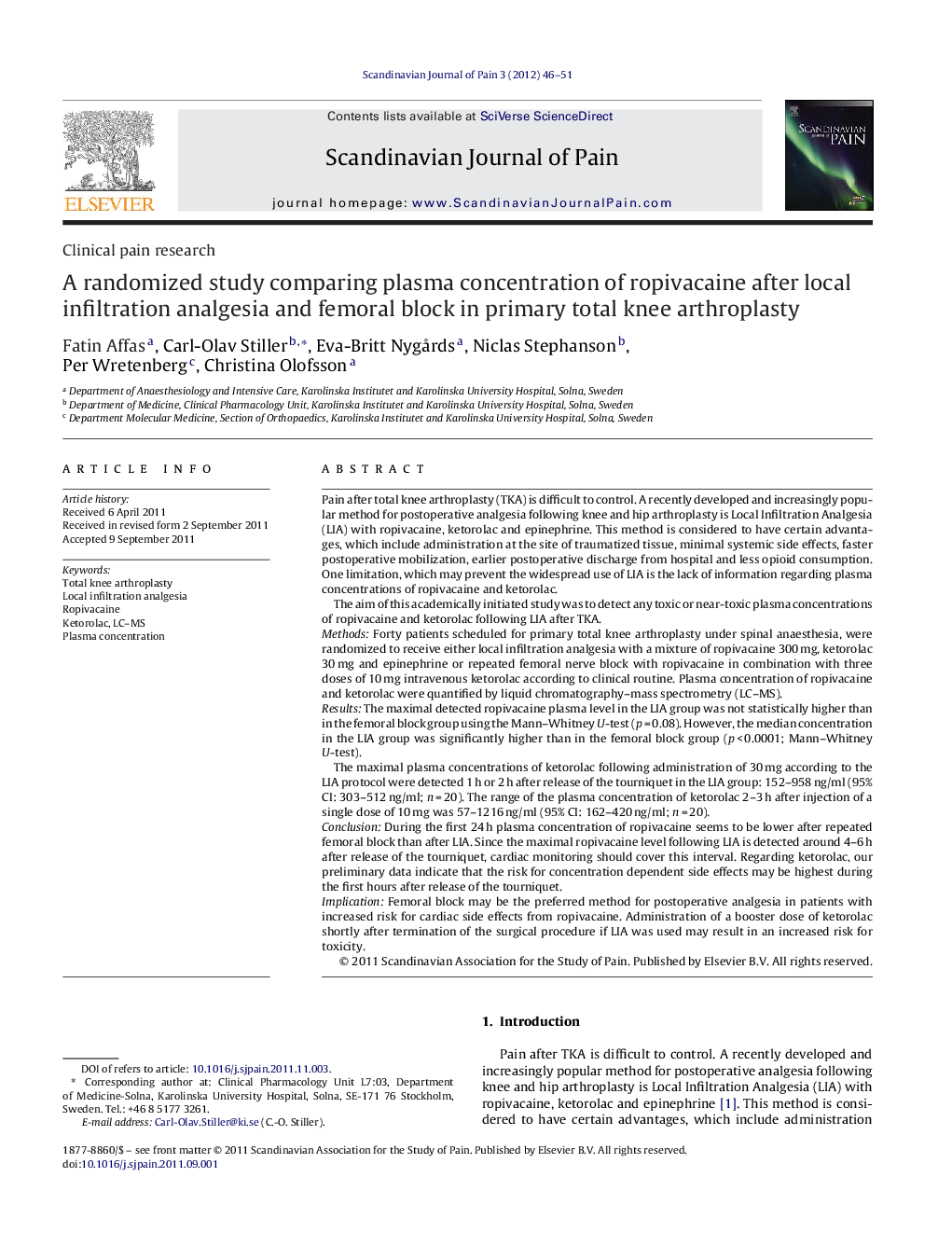| کد مقاله | کد نشریه | سال انتشار | مقاله انگلیسی | نسخه تمام متن |
|---|---|---|---|---|
| 2771058 | 1567826 | 2012 | 6 صفحه PDF | دانلود رایگان |

Pain after total knee arthroplasty (TKA) is difficult to control. A recently developed and increasingly popular method for postoperative analgesia following knee and hip arthroplasty is Local Infiltration Analgesia (LIA) with ropivacaine, ketorolac and epinephrine. This method is considered to have certain advantages, which include administration at the site of traumatized tissue, minimal systemic side effects, faster postoperative mobilization, earlier postoperative discharge from hospital and less opioid consumption. One limitation, which may prevent the widespread use of LIA is the lack of information regarding plasma concentrations of ropivacaine and ketorolac.The aim of this academically initiated study was to detect any toxic or near-toxic plasma concentrations of ropivacaine and ketorolac following LIA after TKA.MethodsForty patients scheduled for primary total knee arthroplasty under spinal anaesthesia, were randomized to receive either local infiltration analgesia with a mixture of ropivacaine 300 mg, ketorolac 30 mg and epinephrine or repeated femoral nerve block with ropivacaine in combination with three doses of 10 mg intravenous ketorolac according to clinical routine. Plasma concentration of ropivacaine and ketorolac were quantified by liquid chromatography–mass spectrometry (LC–MS).ResultsThe maximal detected ropivacaine plasma level in the LIA group was not statistically higher than in the femoral block group using the Mann–Whitney U-test (p = 0.08). However, the median concentration in the LIA group was significantly higher than in the femoral block group (p < 0.0001; Mann–Whitney U-test).The maximal plasma concentrations of ketorolac following administration of 30 mg according to the LIA protocol were detected 1 h or 2 h after release of the tourniquet in the LIA group: 152–958 ng/ml (95% CI: 303–512 ng/ml; n = 20). The range of the plasma concentration of ketorolac 2–3 h after injection of a single dose of 10 mg was 57–1216 ng/ml (95% CI: 162–420 ng/ml; n = 20).ConclusionDuring the first 24 h plasma concentration of ropivacaine seems to be lower after repeated femoral block than after LIA. Since the maximal ropivacaine level following LIA is detected around 4–6 h after release of the tourniquet, cardiac monitoring should cover this interval. Regarding ketorolac, our preliminary data indicate that the risk for concentration dependent side effects may be highest during the first hours after release of the tourniquet.ImplicationFemoral block may be the preferred method for postoperative analgesia in patients with increased risk for cardiac side effects from ropivacaine. Administration of a booster dose of ketorolac shortly after termination of the surgical procedure if LIA was used may result in an increased risk for toxicity.
► High dose ropivacaine is used in local infiltration analgesia (LIA) in knee arthroplasty.
► Some patients reach potentially toxic ropivacaine plasma concentrations after LIA.
► Maximal ropivacaine plasma levels were detected 4–6 h after release of tourniquet of LIA.
► Toxicity monitoring with ECG in risk patients should cover this period of maximal plasma levels.
► Ketorolac is still present in plasma 24 h after local injection of 30 mg as part of the LIA.
Journal: Scandinavian Journal of Pain - Volume 3, Issue 1, January 2012, Pages 46–51